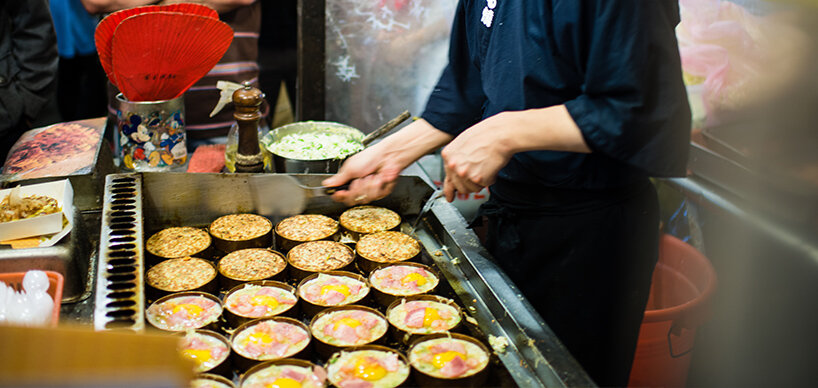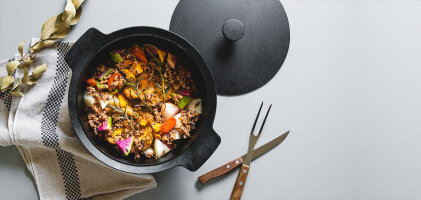Okonomiyaki recipe | Fry what you like


Cooking together makes you happy
Food in Japan is mostly, above all, sociable. And sometimes interactive. When family, friends, and colleagues come together, ready-made meals are rarely served; instead, everyone makes their own. Similar to Sukiyaki, Shabu Shabu, or our fondue, Okonomiyaki also involves each person receiving the ingredients but having to prepare their dish. What sounds like a lot of work actually brings fun and conversation to the table.
What are the ingredients? The base for these Japanese vegetable pancakes usually consists of water or broth, egg, cabbage, green onions, flour, and sometimes tempura batter. This is placed in a bowl and must be thoroughly mixed first. Then comes the preparation. In an Okonomiyaki restaurant, there is a hot plate in the middle of the table where the pancakes are cooked. What else goes in is up to the customer. True to its name: Okonomi roughly translates to "what you want," and Yaki simply means "grill." So, grill it according to your taste: vegetables, noodles, seafood, meat, and more.
If you want to skip the effort in the restaurant, there is also the option to order ready-made Okonomiyaki. They are either cooked right in front of you on your own table or in the kitchen. Everything depends on the restaurant, and each one offers its own specialties. At Japanese street festivals, you can also get these delicious steaming pancakes to go.

Picture Credits: Author:Jorge Gonzalez | Flickr License
Where the special taste comes from
As with any Japanese recipe, there are regional differences here as well. The most famous Okonomiyaki comes from the Kansai region around Kyoto and Osaka, and in Hiroshima, they like to use Yakisoba (fried buckwheat noodles) as the first layer. Additionally, the ingredients are layered here instead of mixed. Okonomiyaki, as we know and love it today, has only been around since the 1930s. The origin lies in Japanese crepe-like recipes. Especially in Hiroshima, they were topped with bonito fish flakes (Katsuobushi), green onions, and Kombu seaweed, then folded for snacking. During World War II, when rice became scarce in Japan, the pancakes became a nutritious alternative. While flour was initially the main ingredient, later, vegetables, eggs, and meat were added.
There are still different variations of this dish: Negiyaki, for example, uses only green onions instead of cabbage. In Tokyo, there is Monjayaki: Here, the ingredients are first fried in a ring. The batter goes in the middle, and everything is eaten directly from the hot plate using a spatula. Small relatives include Takoyaki, dough balls with octopus, which, like Okonomiyaki, are enjoyed with sauce, mayonnaise, and Katsuobushi.
Eating okonomiyaki the right way
Most preferably, one goes to eat Okonomiyaki in Japan with friends, where you prepare it yourself. It's the most delicious and also the most fun when done together. Here's how it goes:
Everyone orders their favorite variation, sometimes agreeing on one. The waiter turns on the iron plate in the middle of the table. It's hot enough as soon as each guest receives a bowl with the Okonomiyaki batter. The content is vigorously mixed with an accompanying spoon. The group needs to spread oil on the hot plate, provided for the customers. Then, the batter is spread on it. It's important to note: Not everyone makes their own pancakes but rather a large flat one that is shared. Depending on the group size, there are usually two per table. The goal is to use the entire bowl if possible, so the batter becomes a bit thicker. Toppings like bacon, octopus, shrimp, or beef strips are placed on top. After some time, a "volunteer" flips the Okonomiyaki.
On the table, there are also Okonomiyaki sauce, Japanese mayonnaise, and dried bonito flakes. These extras are essential for an authentic experience: First, the sauce goes on the Okonomiyaki, followed by the mayonnaise. If desired, one can sprinkle bonito flakes on the Japanese pancake. As they curl up in the heat, they provide an additional visual effect. Sometimes, flakes of Aonori (green dried seaweed) are also added. One cuts the Okonomiyaki with a spatula provided on the table. Then, the pieces are distributed fairly among the diners.
Using a small spatula usually found next to the plate, everyone cuts their piece. And now, the chopsticks come into play. If you're not full yet, you can always reorder.
Make your own Japanese pancakes
 2 personsNo. of persons
2 personsNo. of persons
 ca. 45 minutesTotal Time
ca. 45 minutesTotal Time
 easyLevel of difficulty
easyLevel of difficulty
 main mealDish
main mealDish
 ca. 250kcal per portionCalories
ca. 250kcal per portionCalories
 Vegetarian
Vegetarian
 Eggs
Eggs
 Kitchenware
Kitchenware

|
110g
Okonomiyaki flour (or wheat flour)
|
|
1/2 head
white cabbage, cut into small strips
|
|
1/2 bunch
spring onions (or more to taste)
|
|
120ml
dashi fish stock, thin vegetable stock or water
|
|
2
eggs
|
|
Neutral vegetable oil (e.g. rapeseed oil)
|
|
Toppings to taste: e.g. mushrooms, bamboo shoots, pickled ginger, grated cheese, raw shrimps, beef fillet, bacon strips
|
|
some bonito flakes (to taste)
|
|
Some Aonori or other seaweed flakes (you can also chop up seaweed leaves for this)
|
|
Okonomiyaki sauce and Japanese mayonnaise (more on this below)
|














-from-the-yakiyaki-grill-pan.jpg)




